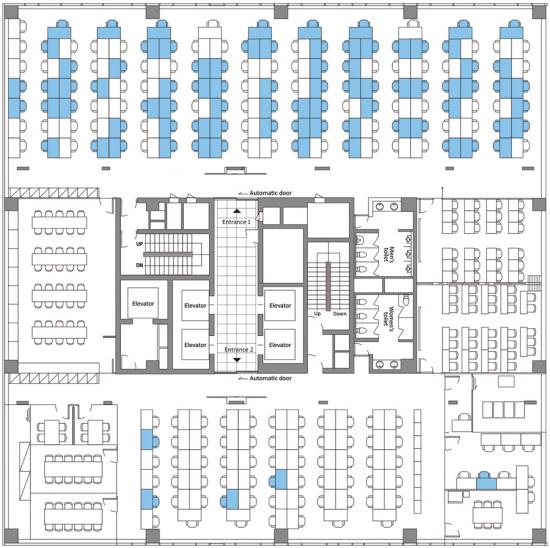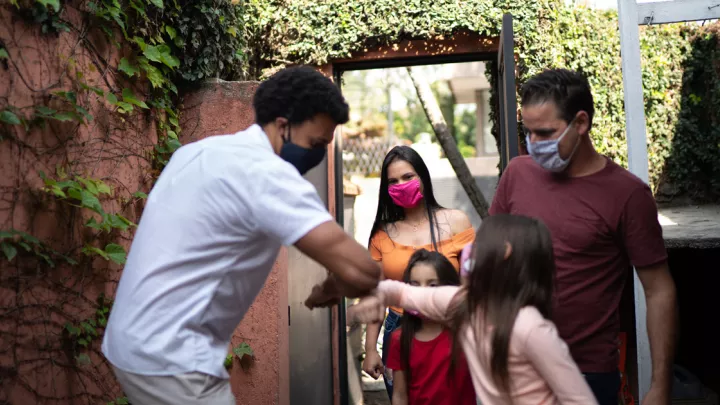How to recognize superspreader events

Casinos, restaurant meals, choir practice, churches, funerals and birthday parties – after going to these types of events, many have tested positive for COVID-19.
What do these superspreader events have in common? To understand how COVID-19 spreads, consider these three Vs:
- Venue: Multiple people indoors, where social distancing is often harder
- Ventilation: Staying in one place with limited fresh air
- Vocalization: Lots of talking, yelling or singing, which can aerosolize the virus
A new study by UNMC researchers indicates airborne transmission is likely for COVID-19. In addition to large respiratory droplets caused by coughing or sneezing, tiny respiratory droplets called aerosols may also spread COVID-19. Aerosols are small enough to float in midair, while large respiratory droplets are heavier and fall to the ground.
In light of this new research, let's look at how you can reduce your risk of catching COVID-19. When choosing to attend a gathering, consider venue, ventilation and vocalization.
Venue
The coronavirus is much more likely to spread indoors rather than outdoors. The odds of catching COVID-19 indoors are 18.7 times higher than in open-air environments, according to a study cited by the Centers for Disease Control and Prevention.
Social distancing at 6 feet was intended as a rough guideline for coughs and sneezes. If COVID-19 is airborne, infectious coronavirus particles can travel farther than 6 feet. Researchers collected airborne coronavirus droplets over 15 feet away from COVID-19 patients. Because of the potential for airborne spread, a big venue is safer than a small one.
The time spent indoors matters. If you're inside with multiple people for hours, social distancing isn't a magic bullet. In a Korean call center, many coworkers' desks were located over 6 feet away from the infected person. They later tested positive for COVID-19.

Some practical ways to limit venue risks:
- Minimize time: Don't stay indoors for long periods of time with others
- Keep your distance: Stay at least 6 feet away from others, preferably more
- Avoid large gatherings: More people means a higher likelihood that someone attending is infected with COVID-19
Ventilation
Ventilation means providing fresh air to a room or building. With an airborne virus, meeting others indoors is riskier than outdoors due to less ventilation.
When you're outdoors, fresh air is everywhere. This means infectious particles are quickly diluted. Think of it as putting a muddy dog in a bathtub full of water – the water gets noticeably dirty. But if you put that same muddy pup in a big pool, the dirt spreads out.
The same idea works with diluting infectious particles. When an infectious person emits coronavirus particles outside, the particles float away with the breeze. When that infectious person is indoors, the coronavirus particles stay contained in a smaller area.
The longer an infectious person remains indoors around other people, the higher the risk. More time means more particles floating in the same enclosed space.
The best way to reduce risk is to limit time indoors with others. Meet outdoors if possible. If you must meet others indoors, here are guidelines adapted from the Ventilation section in our playbook for K-12 schools:
- Minimize recirculation: Increase air exchange rates in buildings and maximize fresh air. Open windows and doors to the outside when possible
- Use filters: Where recirculation is required, explore options for HEPA-equivalent filtering for your HVAC system. Higher-efficiency air filters can capture smaller particles like coronavirus aerosols
- Avoid mixing air between high-risk rooms: Adjust HVAC systems to create negative pressure, or inward directed airflow, in areas of higher risk for contamination and aerosol generation (like bathrooms)
Can turning on your heat kill the coronavirus indoors? Not in a typical building. One study recommends temperatures of at least 140° F to destroy coronavirus particles – far above normal temperature levels inside.
Vocalization
Any time inhaling and exhaling occur there is potential to spread the virus. Talking, yelling, exercising and singing by a positive COVID-19 case can spread infectious droplets.
Some activities spread more particles than others. Singing creates more particles than talking. Talking creates more particles than breathing.
How to limit the risks of vocalization:
- Wear a mask: The best way to prevent spreading viral droplets through vocalization is by wearing a mask
- Don't sing: Singing creates aerosols, tiny droplets that can move farther than large respiratory droplets
- Avoid loud places: Talking over loud music, like at a bar, makes it harder to speak quietly. Loud talking spreads more respiratory droplets than quiet conversation





